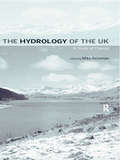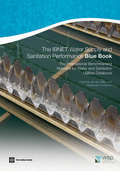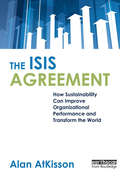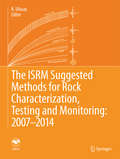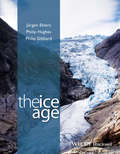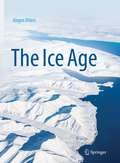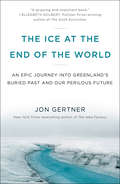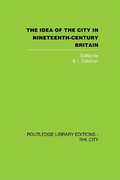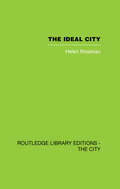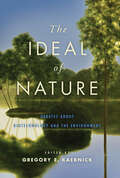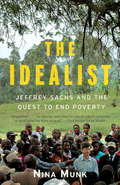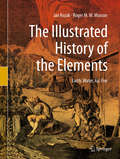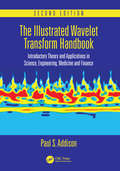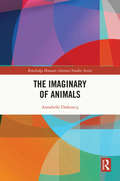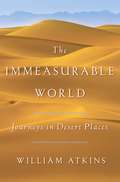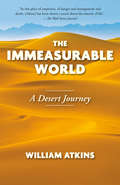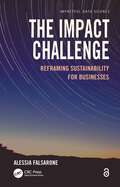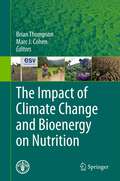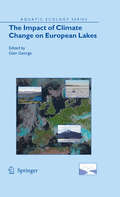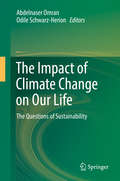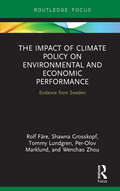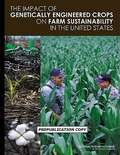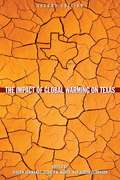- Table View
- List View
The Hydrology of the UK: A Study of Change (Routledge Environmental Management)
by Mike AcremanThe Hydrology of the UK assesses the changing hydrology of the UK, focusing on key issues that affect the fundamental hydrological processes and have important implications for water resource management, flood risk and environmental quality. The bookis divided into 3 sections: Section 1 examines the causes of change to the hydrology of the UK, including the impact of climate change, land use and geomorphological change, and dam construction. Section 2 assesses the effects of these pressures on UK rivers, goundwater, lakes, ponds, reservoirs and wetlands, looking at water quality, degradation, pollution and protection. Section 3 examines the responses of goverment organisations responsible for planning and management of water, including Environment Agencies, British Hydrological Society and the growing urgency for a World Hydrology Initiative.Change will continue to be a major feature of UK hydrology in the future. This book provides an understanding of the changing hydrology of the UK and the international scene today and looks to the needs for the future.
The Hyena Scientist (Scientists in the Field Series)
by Sy Montgomery Nic BishopThis myth-busting new addition to the critically acclaimed Scientists in the Field series by Sibert medal winning team Sy Montgomery and Nic Bishop is perfect for nonfiction readers looking for more female scientist narratives, or a fresh perspective on an underrepresented animal—Hyenas! Timely and inspiring, The Hyena Scientist sets the record straight about one of history’s most hated and misunderstood mammals, while featuring the groundbreaking, pioneering research of a female scientist in a predominately male field in this offering by Sibert-winning duo Sy Montgomery and Nic Bishop. As a scientist studying one of the only mammalian societies led entirely by females, zoologist Kay Holecamp has made it her life’s work to understand hyenas, the fascinating, complex creatures that are playful, social, and highly intelligent—almost nothing like the mangy monsters of pop culture lore.
The IBNET Water Supply and Sanitation Performance Blue Book: The International Benchmarking Network of Water and Sanitation Utilities Databook
by Caroline van den Berg Alexander DanilenkoThis book aims to raise awareness of how the International Benchmarking Network of Water and Sanitation Utilities (IBNET)can help utilities identify ways to improve urban water and wastewater services. It provides an introduction to benchmarking and to the objectives, scope and focus of IBNET and describes some of its recent achievements. The methodology and data behind IBNET are elaborated, and an overview of IBNET results and country data are presented.
The ISIS Agreement: How Sustainability Can Improve Organizational Performance and Transform the World
by Alan AtKissonThis is the must-have book for leaders in business, organizations and government who are scrambling to get a grip on sustainability while improving performance in the era of climate change. Renowned business and sustainability consultant Alan AtKisson distils decades of wisdom and experience into this highly readable and motivational work. Covering theory and practice, obstacles and opportunities, case studies and poignant personal anecdotes, The ISIS Agreement draws the reader ever deeper into a global 'conspiracy of hope.' The core of the book is AtKisson's potent Accelerator, adopted for use in dozens of countries by business, governments, and organizations such as UNEP. A comprehensive toolkit that helps integrate sustainability into organizations, initiatives and plans, it can be used by any group, organization, business, community or region, in virtually any context. Central to the Accelerator is the potent ISIS (Indicators, Systems, Innovation, Strategy) method that teaches leaders how to create a whole-systems view of their organization, to identify and understand blockages and opportunities, and to leverage the potential for innovative change that adds value and accelerates progress towards sustainability.
The ISRM Suggested Methods for Rock Characterization, Testing and Monitoring: 2007-2014
by R. UlusayThis book is a collection of ISRM suggested methods for testing or measuring properties of rocks and rock masses both in the laboratory and in situ, as well as for monitoring the performance of rock engineering structures. The first collection (Yellow Book) has been published in 1981. In order to provide access to all the Suggested Methods in one volume, the ISRM Blue Book was published in 2007 (by the ISRM via the Turkish National Group) and contains the complete set of Suggested Methods from 1974 to 2006 inclusive. The papers in this most recent volume have been published during the last seven years in international journals, mainly in Rock Mechanics and Rock Engineering. They offer guidance for rock characterization procedures and laboratory and field testing and monitoring in rock engineering. These methods provide a definitive procedure for the identification, measurement and evaluation of one or more qualities, characteristics or properties of rocks or rock systems that produces a test result.
The Ice Age
by Dr Jürgen Ehlers Dr Philip Hughes Professor Philip L. GibbardThis book provides a new look at the climatic history of the last 2.6 million years during the ice age, a time of extreme climatic fluctuations that have not yet ended. This period also coincides with important phases of human development from Neanderthals to modern humans, both of whom existed side by side during the last cold stage of the ice age. The ice age has seen dramatic expansions of glaciers and ice sheets, although this has been interspersed with relatively short warmer intervals like the one we live in today. The book focuses on the changing state of these glaciers and the effects of associated climate changes on a wide variety of environments (including mountains, rivers, deserts, oceans and seas) and also plants and animals. For example, at times the Sahara was green and colonized by humans, and Lake Chad covered 350,000 km2 - larger than the United Kingdom. What happened during the ice age can only be reconstructed from the traces that are left in the ground. The work of the geoscientist is similar to that of a detective who has to reconstruct the sequence of events from circumstantial evidence. The book draws on the specialisms and experience of the authors who are experts on the glacial history of the Earth. Readership: Undergraduate and postgraduate students studying the Quaternary, researchers, and anyone interested in climate change, environmental change and geology. The book provides a rich collection of illustrations and photographs to help the readers at all levels visualise the dramatic consequences of glacier expansions during the Ice Age.
The Ice Age
by Jürgen EhlersNothing new from the Ice Age? Far from it! Barely ten years have passed since the first edition of this book was published, but in that time researchers around the world have developed new methods and published their findings in scientific journals. Consequently, ideas about the course of the Ice Age have changed dramatically. The sequence of the individual ice advances, the direction of ice movement and the direction of meltwater drainage are only partially known, but they can be reconstructed. This book offers in-depth information about the state of the investigations.Ice ages are the periods of the earth's history in which at least one polar region is glaciated or covered by sea ice. Thus, we are currently living in an Ice Age. The present Ice Age is also the period in which humans started to intervene in the shaping of the earth. The results are obvious. Aerial and satellite images can be used to trace the melting of glaciers, but also the decay of the Arctic permafrost, and the clearing of the Brazilian rainforest. This book is a translation of the original German 2nd edition Das Eiszeitalter by Juergen Ehlers, published by Springer-Verlag GmbH Germany, part of Springer Nature, in 2020. The translation was done with the help of artificial intelligence (machine translation by DeepL.com). A subsequent human revision was done primarily in terms of content, so that the book will read stylistically differently from a conventional translation. Springer Nature works continuously to further the development of tools for the production of books and promotes technologies to support the authors.
The Ice at the End of the World: An Epic Journey into Greenland's Buried Past and Our Perilous Future
by Jon GertnerA riveting, urgent account of the explorers and scientists racing to understand the rapidly melting ice sheet in Greenland, a dramatic harbinger of climate change“Jon Gertner takes readers to spots few journalists or even explorers have visited. The result is a gripping and important book.”—Elizabeth Kolbert, Pulitzer Prize–winning author of The Sixth Extinction Greenland: a remote, mysterious island five times the size of California but with a population of just 56,000. The ice sheet that covers it is 700 miles wide and 1,500 miles long, and is composed of nearly three quadrillion tons of ice. For the last 150 years, explorers and scientists have sought to understand Greenland—at first hoping that it would serve as a gateway to the North Pole, and later coming to realize that it contained essential information about our climate. Locked within this vast and frozen white desert are some of the most profound secrets about our planet and its future. Greenland’s ice doesn’t just tell us where we’ve been. More urgently, it tells us where we’re headed. In The Ice at the End of the World, Jon Gertner explains how Greenland has evolved from one of earth’s last frontiers to its largest scientific laboratory. The history of Greenland’s ice begins with the explorers who arrived here at the turn of the twentieth century—first on foot, then on skis, then on crude, motorized sleds—and embarked on grueling expeditions that took as long as a year and often ended in frostbitten tragedy. Their original goal was simple: to conquer Greenland’s seemingly infinite interior. Yet their efforts eventually gave way to scientists who built lonely encampments out on the ice and began drilling—one mile, two miles down. Their aim was to pull up ice cores that could reveal the deepest mysteries of earth’s past, going back hundreds of thousands of years. Today, scientists from all over the world are deploying every technological tool available to uncover the secrets of this frozen island before it’s too late. As Greenland’s ice melts and runs off into the sea, it not only threatens to affect hundreds of millions of people who live in coastal areas. It will also have drastic effects on ocean currents, weather systems, economies, and migration patterns. Gertner chronicles the unfathomable hardships, amazing discoveries, and scientific achievements of the Arctic’s explorers and researchers with a transporting, deeply intelligent style—and a keen sense of what this work means for the rest of us. The melting ice sheet in Greenland is, in a way, an analog for time. It contains the past. It reflects the present. It can also tell us how much time we might have left.
The Idea of the City in Nineteenth-Century Britain
by B. I. ColemanIn nineteenth-century Britain, ahead of the rest of the world in economic development, many towns and cities grew to a size that only London had attained before. This volume focuses on the intellectual and controversial response of the period's leading men and women to the key issues of urbanization and its surrounding social problems. The extracts selected date from 1785 to 1909, and are drawn from the writings, reports and speeches of admirers of city life and its most passionate critics, optimists and alarmists, advocates of back-to-the-land panaceas, and reformers who aspired to control and reform cities. Contemporaries quoted include Dickens, Cobbett, Carlyle, Disraeli, Engels, Mrs Gaskell, Ruskin, Joseph Chamberlain, William Morris, Charles Booth, H.G. Wells and Seebohm Rowntree. In a valuable introduction the editor indicates the main preoccupations of the debate abotu the city, proposes a periodization for it, adn shows its connections with other controversies and issues, as Victorian Britain found itself entering an 'age of great cities'. This book was first published in 1973.
The Ideal City: Its Architectural Evolution in Europe
by Helen RosenauThe concept of the 'ideal city' is, perhaps, more important today - when planners and architects are so firmly confined by considerations of our immediate environment - than ever before. Yet it is a concept which has profoundly influenced the western world throughout history, both as a regulative model and as an inspiration. Rosenau traces the progress of the concept from biblical sources through the hellenistic and Roman empires to the Renaissance and the later Age of Enlightenment, when the emphasis shifted from religious to social considerations. She goes on to discuss the resultant nineteenth-century ideal planning, when the idea of social betterment was approached with a specific and conscious effort. This book was first published in 1983.
The Ideal of Nature: Debates about Biotechnology and the Environment
by Gregory E. KaebnickIn this provocative anthology, scholars consider the meaning and merits of “nature” in debates about biotechnology and the environment.Drawing on philosophy, religion, and political science, this book asks what the term “nature” means, how it should be considered, and if it is—even in part—a social construct. The contributors question if the quality of being “natural” is intrinsically valuable. They also discuss whether appeals to nature can and should affect public policy and, if so, whether they are moral trump cards or should instead be weighed against other concerns.Though consensus on these questions remains elusive, this should not be an obstacle to moving the debate forward. By bringing together disparate approaches to addressing these concepts, The Ideal of Nature suggests the possibility of intermediate positions that move beyond the usual full-throated defense and blanket dismissal found in much of the debate. Scholars of bioethics, environmental philosophy, religious studies, sociology, public policy, and political theory will find much merit in this book’s lively discussion.
The Idealist
by Nina MunkNAMED ONE OF THE BEST BOOKS OF THE YEAR BY Bloomberg * Forbes * The SpectatorRecipient of Foreign Policy's 2013 Albie AwardA powerful portrayal of Jeffrey Sachs's ambitious quest to end global poverty "The poor you will always have with you," to cite the Gospel of Matthew 26:11. Jeffrey Sachs--celebrated economist, special advisor to the Secretary General of the United Nations, and author of the influential bestseller The End of Poverty--disagrees. In his view, poverty is a problem that can be solved. With single-minded determination he has attempted to put into practice his theories about ending extreme poverty, to prove that the world's most destitute people can be lifted onto "the ladder of development." In 2006, Sachs launched the Millennium Villages Project, a daring five-year experiment designed to test his theories in Africa. The first Millennium village was in Sauri, a remote cluster of farming communities in western Kenya. The initial results were encouraging. With his first taste of success, and backed by one hundred twenty million dollars from George Soros and other likeminded donors, Sachs rolled out a dozen model villages in ten sub-Saharan countries. Once his approach was validated it would be scaled up across the entire continent. At least that was the idea. For the past six years, Nina Munk has reported deeply on the Millennium Villages Project, accompanying Sachs on his official trips to Africa and listening in on conversations with heads-of-state, humanitarian organizations, rival economists, and development experts. She has immersed herself in the lives of people in two Millennium villages: Ruhiira, in southwest Uganda, and Dertu, in the arid borderland between Kenya and Somalia. Accepting the hospitality of camel herders and small-hold farmers, and witnessing their struggle to survive, Munk came to understand the real-life issues that challenge Sachs's formula for ending global poverty. THE IDEALIST is the profound and moving story of what happens when the abstract theories of a brilliant, driven man meet the reality of human life.
The Illustrated History of the Elements: Earth, Water, Air, Fire
by Jan Kozák Roger M. MussonThis beautiful art book portrays the forces of nature through the main elements of Earth, Water, Air, Fire. It is composed from a large selection of unique images of a wide variety of sources, mostly private collections. It is a highly illustrated book, containing reproductions of rare engravings, maps both old and new, sketches, and diagrams. The book is a sequel to ‘The Illustrated History of Natural Disasters’, published in 2010. While the first book provided a detailed look into two main kinds of natural disasters (of seismic and volcanic character), this volume presents natural disasters of all kinds: geophysical, hydrological, climatological and biological. The book is divided into three parts: the first part introduces the leading question as to whether the elements should be regarded as constructive, for giving origin to life on Earth, or destructive given the impact of natural disasters to society throughout history; the second illustrates the positive effects of nature’s elements; and the third part depicts and contextualizes the history of natural disasters such as earthquakes, tsunamis, volcano eruptions, landslides, avalanches, draughts, storms, fires, among others.
The Illustrated Wavelet Transform Handbook: Introductory Theory and Applications in Science, Engineering, Medicine and Finance, Second Edition
by Paul S. AddisonThis second edition of The Illustrated Wavelet Transform Handbook: Introductory Theory and Applications in Science, Engineering, Medicine and Finance has been fully updated and revised to reflect recent developments in the theory and practical applications of wavelet transform methods. The book is designed specifically for the applied reader in science, engineering, medicine and finance. Newcomers to the subject will find an accessible and clear account of the theory of continuous and discrete wavelet transforms, while readers already acquainted with wavelets can use the book to broaden their perspective. One of the many strengths of the book is its use of several hundred illustrations, some in colour, to convey key concepts and their varied practical uses. Chapters exploring these practical applications highlight both the similarities and differences in wavelet transform methods across different disciplines and also provide a comprehensive list of over 1000 references that will serve as a valuable resource for further study. Paul Addison is a Technical Fellow with Medtronic, a global medical technology company. Previously, he was co-founder and CEO of start-up company, CardioDigital Ltd (and later co-founded its US subsidiary, CardioDigital Inc) - a company concerned with the development of novel wavelet-based methods for biosignal analysis. He has a master’s degree in engineering and a PhD in fluid mechanics, both from the University of Glasgow, Scotland (founded 1451). His former academic life as a tenured professor of fluids engineering included the output of a large number of technical papers, covering many aspects of engineering and bioengineering, and two textbooks: Fractals and Chaos: An Illustrated Course and the first edition of The Illustrated Wavelet Transform Handbook. At the time of publication, the author has over 100 issued US patents concerning a wide range of medical device technologies, many of these concerning the wavelet transform analysis of biosignals. He is both a Chartered Engineer and Chartered Physicist.
The Imaginary of Animals (Routledge Human-Animal Studies Series)
by Annabelle DufourcqThis book explores the phenomenon of animal imagination and its profound power over the human imagination. It examines the structural and ethical role that the human imagination must play to provide an interface between humans’ subjectivity and the real cognitive capacities of animals. The book offers a systematic study of the increasing importance of the metaphors, the virtual, and figures in contemporary animal studies. It explores human-animal and real-imaginary dichotomies, revealing them to be the source of oppressive cultural structures. Through an analysis of creative, playful and theatric enactments and mimicry of animal behaviors and communication, the book establishes that human imagination is based on animal imagination. This helps redefine our traditional knowledge about animals and presents new practices and ethical concerns in regard to the animals. The book strongly contends that allowing imagination to play a role in our relation to animals will lead to the development of a more empathetic approach towards them. Drawing on works in phenomenology, contemporary animal philosophy, as well as ethological evidence and biosemiotics, this book is the first to rethink the traditional philosophical concepts of imagination, images, the imaginary, and reality in the light of a zoocentric perspective. It will appeal to philosophers, scholars and students in the field of animal studies, as well as anyone interested in human and non-human imaginations.
The Immeasurable World: Journeys in Desert Places
by William AtkinsIn the classic literary tradition of Bruce Chatwin and Geoff Dyer, and for readers of Ryszard Kapuscinski and Rory Stewart, a rich and exquisitely written account of travels in eight deserts on five continents that evokes the timeless allure of these remote and forbidding places and their inhabitants.One-third of the earth's land surface is classified as desert. Restless, unhappy in love, and intrigued by the Desert Fathers who forged Christian monasticism in the Egyptian desert, William Atkins decided to travel in six of the world's driest, hottest places: the Empty Quarter of Oman, the Gobi and Taklamakan Desert of northwest China, the Great Victoria Desert of Australia, the man-made desert of the Aral Sea in Kazkahstan, and the Black Rock and Sonoran Deserts of the American Southwest, and Egypt's Eastern Desert. Each of his travel narratives effortlessly weaves aspects of natural history, historical background, and present-day reportage into a compelling tapestry that reveals the human appeal of these often inhuman landscapes.
The Immeasurable World: Journeys in Desert Places
by William AtkinsIn the classic literary tradition of Bruce Chatwin and Geoff Dyer, a rich and exquisitely written account of travels in eight deserts on five continents that evokes the timeless allure of these remote and forbidding places.One-third of the earth's surface is classified as desert. Restless, unhappy in love, and intrigued by the Desert Fathers who forged Christian monasticism in the Egyptian desert, William Atkins decided to travel in eight of the world's driest, hottest places: the Empty Quarter of Oman, the Gobi Desert and Taklamakan deserts of northwest China, the Great Victoria Desert of Australia, the man-made desert of the Aral Sea in Kazkahstan, the Black Rock and Sonoran Deserts of the American Southwest, and Egypt's Eastern Desert. Each of his travel narratives effortlessly weaves aspects of natural history, historical background, and present-day reportage into a compelling tapestry that reveals the human appeal of these often inhuman landscapes.
The Impact Challenge: Reframing Sustainability for Businesses (Impactful Data Science)
by Alessia FalsaroneThis book explores the role of businesses in delivering positive societal and financial outcomes as they seek to bridge the gap between short-term organizational behaviors and long-range sustainability commitments. By addressing the inevitable data challenges associated with the strategic integration of a sustainability mindset, it enables faster adoption of social, environmental and governance metrics that generate lasting enterprise value. Inspired by the experience of practitioners that have successfully influenced the learning behaviors of complex organizations, this book helps readers drive systemic innovations as they leverage sustainability initiatives in a programmatic and intentional manner. Features: Defines a toolkit to generate sustainable business value by focusing on the organizational design underpinning sustainability-oriented initiatives. Provides a multidisciplinary lens on shaping the impact dialogue through applied frameworks. Discusses the need to analytically identify an organizational learning curve before developing impact targets and framing sustainability commitments around them. Combines theory and practice in a practical style by presenting a variety of real-life applications at a global level.
The Impact of Climate Change and Bioenergy on Nutrition
by Brian Thompson Marc J CohenClimate changes will affect food production in a number of ways. Crop yields, aquatic populations and forest productivity will decline, invasive insect and plant species will proliferate and desertification, soil salinization and water stress will increase. Each of these impacts will decrease food and nutrition security, primarily by reducing access to and availability of food, and also by increasing the risk of infectious disease. Although increased biofuel demand has the potential to increase incomes among producers, it can also negatively affect food and nutrition security. Land used for cultivating food crops may be diverted to biofuel production, creating food shortages and raising prices. Accelerations in unregulated or poorly regulated foreign direct investment, deforestation and unsustainable use of chemical fertilizers may also result. Biofuel production may reduce women's control of resources, which may in turn reduce the quality of household diets. Each of these effects increases risk of poor food and nutrition security, either through decreased physical availability of food, decreased purchasing power, or increased risk of disease. The Impact of Climate Change and Bioenergy on Nutrition articulates the links between current environmental issues and food and nutrition security. It provides a unique collection of nutrition statistics, climate change projections, biofuel scenarios and food security information under one cover which will be of interest to policymakers, academia, agronomists, food and nutrition security planners, programme implementers, health workers and all those concerned about the current challenges of climate change, energy production, hunger and malnutrition.
The Impact of Climate Change on European Lakes
by Glen GeorgeIn this book, scientists from eleven countries summarize the results of an EU project (CLIME) that explored the effects of observed and projected changes in the climate on the dynamics of lakes in Northern, Western and Central Europe. Historical measurements from eighteen sites were used to compare the seasonal dynamics of the lakes and to assess their sensitivity to local, regional and global-scale changes in the weather. Simulations using a common set of water quality models, perturbed by six climate-change scenarios, were then used to assess the uncertainties associated with the projected changes in the climate. The book includes chapters on the phenology and modelling of lake ice, the supply and recycling of nitrogen and phosphorus, the flux of dissolved organic carbon and the growth and the seasonal succession of phytoplankton. There are also chapters on the coherent responses of lakes to changes in the circulation of the atmosphere, the development of a web-based Decision Support System and the implications of climate change for the Water Framework Directive.
The Impact of Climate Change on Our Life: The Questions Of Sustainability
by Odile Schwarz-Herion Abdelnaser OmranThis book introduces the highly topical issue from many different angles, sensitizing readers to the various challenges to human life posed by climate change, identifying possible intentional and inadvertent anthropogenic factors and consequences, and seeking socially and environmentally viable solutions. The book begins by examining the impact of the climate change discussion on science, politics, economy and culture – from its historical origin in the first Club of Rome Report and its inclusion in the UN's SDGs to the Paris Agreement and beyond. Comprising 12 chapters, it analyses the factors which caused the catastrophic 2014 Kelantan flood in Malaysia, focusing on the Kuala Krai district and discusses mud architecture in Wadi Hadramout, Yemen and mitigating the expected effects of climate change on this unique architecture and cultural heritage. It also examines the economic costs of climate change on health and the increased burden on individual expenditures and national health systems. The role of climate change in the water-energy nexus and efforts to increase efficiency in energy and water end-use to increase Queensland’s agricultural sector’s resilience in Australia is addressed, as is water security and climate change issues in developing countries and the potential of partnership procurement strategies for managing sustainable urban water supply in Nigerian cities. It also includes a chapter offering a new approach to waste management, exploring to what extent waste can complicate our daily actions and influence environmental decay, and recommending that renewable materials be sorted and separated from other types of materials to avoid cross-contamination, to increase the value of the materials, and to ease the process of manufacturing. Subsequent chapters identify factors sustaining the municipal solid waste management and practices in Ajdabiya city in Libya, and look at accounting disclosure remedies by exploring areas in which sustainability reporting could expand beyond corporate environmental reporting to additional disclosures, curbing recklessness in pursuing merely economic goals. The book shows – from the perspective of agriculture – how human activities can increase the negative impacts of climate change on lifestyle in Malaysia, suggesting alternative lifestyles and encouraging international cooperative efforts. The last chapters evaluate the impacts of various environmental factors on the local tourism sector in Pakistan, and discuss strategies to tackle climate change, focusing on the opportunities and risks of climate engineering. Since these risks encompass inadvertent negative effects and targeted abuse for covert weather warfare and terrorism that violate the UN’s ENMOD convention, the author recommends viable alternatives to deal with climate change.
The Impact of Climate Policy on Environmental and Economic Performance: Evidence from Sweden (Routledge Explorations in Environmental Economics)
by Rolf Färe Shawna Grosskopf Tommy Lundgren Per-Olov Marklund Wenchao ZhouSweden has a long history of ambitious environmental, energy and climate policy. Due to the large amount of data available it is possible to perform statistically sound analysis and assess long term changes in productivity, efficiency, and technological development. The data at hand together with Sweden’s ambitious energy and climate policy provides a unique opportunity to shed light on pertinent policy issues. <P><P>The Impact of Climate Policy on Environmental and Economic Performance answers several key questions: What is the effect of the CO2 tax on environmental performance and profitability of firms? Does including emissions in productivity measurement of the industrial firm matter? Did the introduction of the EU ETS spur technological development in the Swedish industrial firm? What air pollutant is most inhibiting production when regulated? Being aware and learning from the Swedish case can be very relevant for countries that are in the process of shaping their climate policy. <P><P>This book is of great importance to researchers and policy makers who are interested in environmental economics, industrial economics and climate change.
The Impact of Genetically Engineered Crops on Farm Sustainability in the United States
by National Research Council of the National AcademiesSince genetically engineered (GE) crops were introduced in 1996, their use in the United States has grown rapidly, accounting for 80-90 percent of soybean, corn, and cotton acreage in 2009. To date, crops with traits that provide resistance to some herbicides and to specific insect pests have benefited adopting farmers by reducing crop losses to insect damage, by increasing flexibility in time management, and by facilitating the use of more environmentally friendly pesticides and tillage practices. However, excessive reliance on a single technology combined with a lack of diverse farming practices could undermine the economic and environmental gains from these GE crops. Other challenges could hinder the application of the technology to a broader spectrum of crops and uses. Several reports from the National Research Council have addressed the effects of GE crops on the environment and on human health. However, The Impact of Genetically Engineered Crops on Farm Sustainability in the United States is the first comprehensive assessment of the environmental, economic, and social impacts of the GE-crop revolution on U.S. farms. It addresses how GE crops have affected U.S. farmers, both adopters and nonadopters of the technology, their incomes, agronomic practices, production decisions, environmental resources, and personal well-being. The book offers several new findings and four recommendations that could be useful to farmers, industry, science organizations, policy makers, and others in government agencies.
The Impact of Global Warming on Texas
by Jurgen Schmandt Gerald R. North Judith ClarksonOverall, this book is an admirable attempt at a discussion of the effects of global warming, and should stimulate discussions of policy options at the state, and even national, level. . . . This thought-provoking book is suitable for environmental decisionmakers in Texas (or in any state) who are trying to deal with global climate change. The book is ideal for supplementing college classes in environmental management and policy. --Science Books and Films This is the most wide-ranging, integrated analysis of climate change impacts on a region that I have seen. . . . it should be read carefully by anyone attempting to assess what climate change means for their region. --William E. Riebsame, associate professor of geography, University of Colorado, Boulder The presence of uncertainty need not immobilize us like a deer trapped in the headlights of an onrushing truck. There is enough information to craft a sound program for a rational response to climate change in Texas. So concludes this report of the Task Force on Climate Change in Texas, an interdisciplinary group of experts convened to study the possible effects of global warming on Texas and to identify policy options for avoiding or mitigating them. After introductory chapters on global climate change, the changing Texas climate, and greenhouse emissions, individual chapters of this study explore the effects of global warming on Texas water resources, estuaries, biodiversity, agriculture, urban areas, and the economy. These essays reveal a wide range of possible effects, from severe stresses on water and coastal resources to low impact in the agricultural sector and in urban areas. Policy options for reducingemissions and mitigating some of their effects are included. Gerald R. North is a distinguished professor of meteorology and oceanography at Texas A & M University. Jurgen Schmandt is director of the Center for Global Studies of the Houston Advanced Research Center and a professor of public affairs at the University of Texas at Austin. Judith Clarkson is a consultant to the Center for Global Studies.
The Impact of High-Speed Railway Development on Regional Spatial Structure in China (Urban Sustainability)
by Yunyun WangUsing the theoretical framework of new economic geography and the research methods of GIS and econometrics, this book analyzes the impact of high-speed railway development on China's economic distribution, population mobility and regional integration. The development of high-speed railway has subverted the traditional mode of transportation, greatly shortened the time and space distance between cities, and people's travel patterns, employment choices and production behaviors have undergone profound changes accordingly, which has had an increasing impact on economic and social development. The findings of this book have important theoretical and practical significance for China's transportation infrastructure construction and regional spatial development. The book is intended for researchers in urban planning, economics, geography and readers interested in regional spatial development in China.
